
10 Creative Ideas for Raised Garden Beds That Boost Style and Harvest
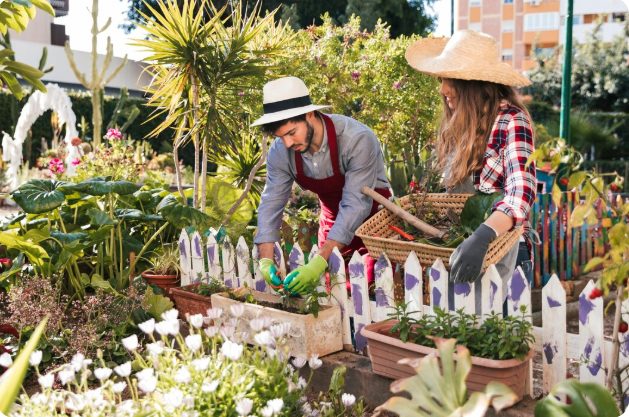
Raised garden beds offer more than just neat rows of plants. They give your garden a fresh look, make planting easier, and improve soil drainage.
With the right design, they can also become a standout feature in your yard. From wood and stone to recycled materials, raised beds work well in both small and large spaces.
You can use them to grow vegetables, flowers, or herbs right at home without bending too much or worrying about poor soil.
A raised bed allows for better control over your garden’s layout. You get to set the height, shape, and location.
That means more comfort and more creativity. Whether your space is sunny or shaded, there’s always a design that fits.
Some gardeners even use their beds as natural borders or to separate crops. This post shares ten raised garden bed ideas that are easy to try, visually appealing, and practical for any yard.
10 Ideas for Raised Garden Beds
Raised garden beds are a smart way to grow plants. They make gardening easier, cleaner, and more beautiful.
These beds help you avoid poor soil and keep weeds under control. You can also place them anywhere—backyards, balconies, or even rooftops.
Whether you grow vegetables, herbs, or flowers, raised beds work in all kinds of spaces. Below are 10 great ideas to try. Each one brings something special to your garden.
1. Wooden Box Garden Beds
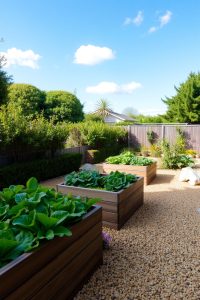
Wooden boxes are a classic choice. They are easy to build, budget-friendly, and look natural. Most people use cedar or redwood because these last long and resist rot.
Make simple square or rectangle shapes. Keep the height around 12 to 18 inches. That gives roots room to grow. Add soil mix, compost, and your favorite plants.
Place mulch on top to keep moisture in. Wooden beds fit well in vegetable gardens, flower areas, or small spaces. Add wheels or handles if you need to move them.
2. Cinder Block Raised Beds
Cinder blocks work well and cost less. Arrange the blocks in a rectangle and fill the center with soil. Use the holes in each block as small planters for herbs or flowers.
These beds don’t need nails or tools. Just stack the blocks. You can also paint them to match your garden style.
They last for years and don’t rot. Make sure to place them on flat ground. They can get hot in summer, so use mulch to protect your plants.
3. Metal Raised Garden Beds
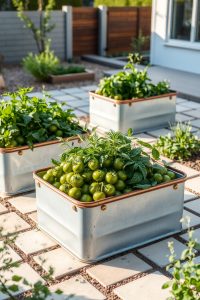
Metal beds bring a modern look. Galvanized steel or corrugated metal works best. It does not rust quickly and lasts for years.
Buy ready-made kits or build your own frame. Keep the corners safe with rubber covers or wood caps. These beds look sharp and hold shape well.
Place them where they get good sunlight. Use quality soil to support root growth. Metal heats up fast, so water the plants often in summer.
4. Tiered Raised Beds
Tiered beds use vertical space well. They give a nice look and make planting easy. The steps allow more light and air to reach every level.
Use wood or bricks to build three to four layers. Place low-growing plants at the top and taller ones at the bottom. This also keeps water from washing soil away.
Tiered beds are great for flowers, strawberries, and herbs. They fit well in corners or narrow spaces.
5. Raised Beds with Trellis
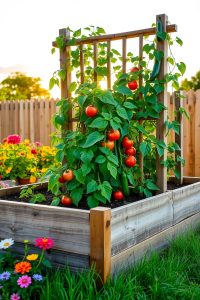
Trellis beds help climbing plants like tomatoes, beans, and cucumbers grow up. This saves space and looks tidy.
Use wood, wire mesh, or bamboo poles to build the trellis. Attach the trellis to one side of the bed. Let vines climb while short plants grow in the front.
This gives shade and keeps fruit off the ground. It works well in vegetable gardens. Choose strong materials that can support heavy plants.
6. Recycled Material Garden Beds
Old materials can turn into useful garden beds. Use bricks, pallets, barrels, or even old drawers. This saves money and reduces waste.
Arrange bricks in a square or circle. Place barrels on their side and cut out the top. Stack wooden pallets to make tall beds. Make sure each item is safe and clean.
These beds bring charm and show creativity. They work well in rustic or cottage-style gardens.
7. Raised Beds with Bench Seating
Add seating around your raised beds to rest or garden comfortably. Attach wooden benches along the edges of your garden box. Use strong wood like cedar.
Make the bed high enough to sit. This helps older gardeners or those with limited movement. It also gives the garden a clean, finished look.
Grow herbs or flowers for beauty and easy harvest. These beds are perfect for patios or decks.
8. Keyhole Raised Beds
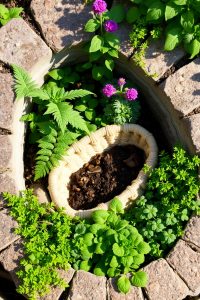
Keyhole beds have a path in the middle like a slice of pie. This lets you reach every part without stepping on the soil. It helps with airflow and keeps the soil loose.
Build a round or horseshoe shape using bricks, stone, or wood. Add a compost bin in the center to feed the soil over time.
This design works well in small yards. It looks nice and helps save water too.
9. U-Shaped Raised Beds
U-shaped beds make gardening easier. You can walk into the middle and reach both sides. This shape saves time and keeps your plants safe from foot traffic.
Use wood, bricks, or metal to form the U shape. Make the path wide enough to walk and work. Keep the height at least 12 inches for deep roots.
These beds suit larger gardens and let you grow many types of plants in one spot.
10. Raised Beds for Small Spaces
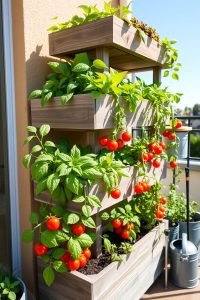
Small yards or balconies still have room for raised beds. Use containers, boxes, or stackable beds to grow upward. Try vertical planters or wall-mounted boxes.
Use lightweight soil and place the bed near sunlight. Grow herbs, salad greens, or small root vegetables.
Compact raised beds need less care. They work well in apartments or urban homes. Add wheels if you want to move them around.
FAQs
What is the best material for raised garden beds?
Cedar, redwood, and galvanized metal are strong and last long. Cinder blocks and bricks also work well. Use safe, untreated materials.
How deep should a raised garden bed be?
Most beds should be at least 12 inches deep. For root vegetables, go deeper—about 18 to 24 inches.
Can I place raised beds on grass?
Yes. Remove the top grass layer or cover it with cardboard before adding soil. This helps stop weeds.
How do I stop weeds in raised beds?
Use a weed barrier like cardboard or landscape fabric at the bottom. Add mulch on top of the soil.
What kind of soil works best?
Use a mix of garden soil, compost, and organic matter. This keeps the soil light, rich, and full of nutrients.
Do raised beds need drainage?
Yes. Add holes or gravel at the bottom for water to flow out. This stops roots from rotting.
How often should I water my raised beds?
In hot weather, water daily. In cooler months, check the soil and water when dry. Raised beds dry faster than ground soil.
Can I grow flowers in raised garden beds?
Yes. Raised beds are great for flowers. Choose plants that fit your space, light, and soil.
Are raised beds good for beginners?
Yes. They are easy to set up and take care of. They help with weeds, soil quality, and pest control.
Do I need to add fertilizer?
Yes. Add compost or slow-release fertilizer every few weeks to keep plants healthy.
Conclusion
Raised garden beds make gardening simple, neat, and fun. They fit in big backyards, small patios, and everything in between.
From wood to stone, square to U-shape, there’s a design for every space and every gardener. Each idea shared above brings its own charm and purpose.
Some save space. Some add beauty. All of them make gardening better. Try one or more, and enjoy fresh flowers, herbs, or vegetables right from your own raised bed garden.
